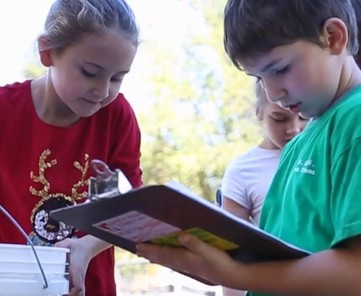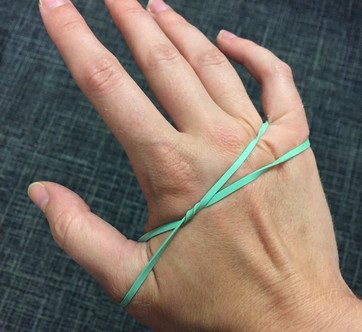| Featured Resource
 (Credit: One Cool Earth)
How to Zero Waste Your School
One Cool Earth, through a project funded by the NOAA Marine Debris Program, worked with 17 schools in California to implement school-wide litter and waste reduction programs. Through this project, a guide to "zero waste your school in 3 easy steps" was created.
Get your school on board and reduce your waste by rethinking, reducing, reusing and recycling resources, and imitating natural cycles. Check out One Cool Earth's guide to get you started!
Featured Activity
 Rubber Band Entanglement
Need a quick activity that your students can do at their desks? Teach your students about the hazards of marine debris with this simple and interactive "rubber band entanglement" activity. Students hook a rubber band onto their thumb and pinkie fingers, looping around the back of the hand as shown above (use your educator discretion with your class to avoid rubber bands shooting across the room). Given thirty seconds or so, students must try to remove the rubber band without using their other hand and without rubbing against anything. They quickly realize just how hard it can be to get "disentangled."
Check out a demonstration of this and other activities in the Trash Talk Webinar for Educators!
Marine Debris Craft Corner
 Plastic Bottle Upcycling
Have some plastic bottles laying around from before you realized how easy it is to use reusable? Rather than recycling them, upcycle them! There are so many things you can do with old plastic bottles. Try turning them into a planter, pencil holder, or even a doll! For a fun and very simple class craft, here's some easy instructions for turning a plastic bottle into a piggy bank. Let it be a reminder to save both some money and our planet!
Instructions:
Step 1: Using scissors or a knife, cut a slit on the side of a plastic bottle. Make sure it's both long and wide enough to fit coins.
Step 2: Place the plastic bottle on its side, with the slit facing upwards. Attach four "legs" to the bottom of the bottle to prevent it from rolling around. You can do this using thumbtacks, or by attaching small items such as pebbles, toothpaste caps, or even rolled paper with glue.
Step 3: Decorate your piggy bank and then start saving!
|